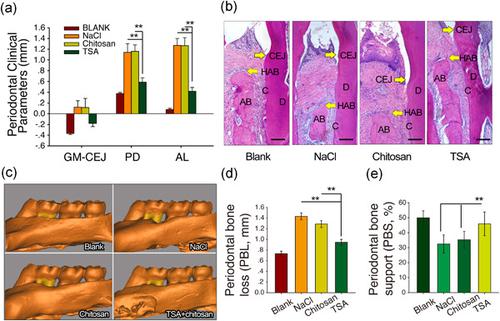当前位置:
X-MOL 学术
›
J. Cell. Physiol.
›
论文详情
Our official English website, www.x-mol.net, welcomes your
feedback! (Note: you will need to create a separate account there.)
Epigenetic modifier trichostatin A enhanced osteogenic differentiation of mesenchymal stem cells by inhibiting NF-κB (p65) DNA binding and promoted periodontal repair in rats.
Journal of Cellular Physiology ( IF 4.5 ) Pub Date : 2020-05-12 , DOI: 10.1002/jcp.29780 Qiong Li 1 , Fan Liu 1 , Rui Dang 1 , Chunyue Feng 1 , Rui Xiao 1 , Ye Hua 1 , Wei Wang 1 , Zhi Jia 1 , Dayong Liu 1, 2
Journal of Cellular Physiology ( IF 4.5 ) Pub Date : 2020-05-12 , DOI: 10.1002/jcp.29780 Qiong Li 1 , Fan Liu 1 , Rui Dang 1 , Chunyue Feng 1 , Rui Xiao 1 , Ye Hua 1 , Wei Wang 1 , Zhi Jia 1 , Dayong Liu 1, 2
Affiliation

|
We wished to evaluate whether epigenetic modifiers have a beneficial effect on treating experimental periodontitis and mechanisms for regulating the cell fate of mesenchymal stem cells (MSCs) in inflammatory microenvironments. We isolated MSCs from healthy and inflamed gingival tissues to investigate whether trichostatin A (TSA) could improve osteogenic differentiation and resolve inflammation in vitro. The tissue regenerative potentials were evaluated when treated with a temperature‐dependent, chitosan‐scaffold‐encapsulated TSA, in a rat model of periodontitis. After induction with the conditioned medium, TSA treatment increased the osteogenic differentiation potential of inflamed MSCs and healthy MSCs. In addition, interleukin‐6 and interleukin‐8 levels in supernatants were significantly decreased after TSA treatment. Moreover, TSA promoted osteogenic differentiation by inhibiting nuclear factor‐κB (p65) DNA binding in MSCs. In rats with experimental periodontitis, 7 weeks after local injections of chitosan‐scaffold‐encapsulated TSA, histology and microcomputed tomography showed a significant increase in alveolar bone volume and less inflammatory infiltration compared with vehicle‐treated rats. The concentrations of interferon‐γ and interleukin‐6 were significantly decreased in the gingival crevicular fluid after TSA treatment. This study demonstrated that TSA had anti‐inflammatory properties and could promote periodontal tissue repair, which indicated that epigenetic modifiers hold promise as a potential therapeutic option for periodontal tissue repair.
中文翻译:

表观遗传修饰剂曲古抑菌素A通过抑制NF-κB(p65)DNA结合并促进大鼠牙周修复来增强间充质干细胞的成骨分化。
我们希望评估表观遗传修饰剂是否对治疗实验性牙周炎和调节炎症性微环境中间充质干细胞(MSC)的细胞命运具有有益的作用。我们从健康和发炎的牙龈组织中分离了MSC,以研究曲古抑菌素A(TSA)是否可以改善成骨分化并在体外解决炎症。在牙周炎的大鼠模型中,用温度依赖性,壳聚糖支架包裹的TSA处理后,评估了组织的再生潜力。用条件培养基诱导后,TSA处理增加了发炎MSC和健康MSC的成骨分化潜能。此外,TSA处理后,上清液中的白细胞介素-6和白细胞介素-8水平显着降低。此外,TSA通过抑制MSC中的核因子κB(p65)DNA结合来促进成骨分化。在实验性牙周炎的大鼠中,局部注射壳聚糖支架包裹的TSA后7周,组织学和微计算机断层扫描显示,与载体治疗的大鼠相比,牙槽骨量显着增加,炎症浸润较少。TSA治疗后龈沟液中干扰素-γ和白介素-6的浓度显着降低。这项研究表明,TSA具有抗炎特性,并且可以促进牙周组织修复,这表明表观遗传修饰剂有望成为牙周组织修复的潜在治疗选择。在实验性牙周炎的大鼠中,局部注射壳聚糖支架包裹的TSA后7周,组织学和微计算机断层扫描显示,与载体治疗的大鼠相比,牙槽骨量显着增加,炎症浸润较少。TSA治疗后龈沟液中干扰素-γ和白介素-6的浓度显着降低。这项研究表明,TSA具有抗炎特性,并且可以促进牙周组织修复,这表明表观遗传修饰剂有望成为牙周组织修复的潜在治疗选择。在实验性牙周炎的大鼠中,局部注射壳聚糖支架包裹的TSA后7周,组织学和显微计算机断层扫描显示,与载体治疗的大鼠相比,牙槽骨量显着增加,炎性浸润较少。TSA治疗后龈沟液中干扰素-γ和白介素-6的浓度显着降低。这项研究表明,TSA具有抗炎特性,并且可以促进牙周组织修复,这表明表观遗传修饰剂有望成为牙周组织修复的潜在治疗选择。组织学和微计算机断层扫描显示,与溶媒治疗的大鼠相比,牙槽骨体积显着增加,炎症浸润较少。TSA治疗后龈沟液中干扰素-γ和白介素-6的浓度显着降低。这项研究表明,TSA具有抗炎特性,并且可以促进牙周组织修复,这表明表观遗传修饰剂有望成为牙周组织修复的潜在治疗选择。组织学和微计算机断层扫描显示,与溶媒治疗的大鼠相比,牙槽骨体积显着增加,炎症浸润较少。TSA治疗后龈沟液中干扰素-γ和白介素-6的浓度显着降低。这项研究表明,TSA具有抗炎特性,并且可以促进牙周组织修复,这表明表观遗传修饰剂有望成为牙周组织修复的潜在治疗选择。
更新日期:2020-05-12
中文翻译:

表观遗传修饰剂曲古抑菌素A通过抑制NF-κB(p65)DNA结合并促进大鼠牙周修复来增强间充质干细胞的成骨分化。
我们希望评估表观遗传修饰剂是否对治疗实验性牙周炎和调节炎症性微环境中间充质干细胞(MSC)的细胞命运具有有益的作用。我们从健康和发炎的牙龈组织中分离了MSC,以研究曲古抑菌素A(TSA)是否可以改善成骨分化并在体外解决炎症。在牙周炎的大鼠模型中,用温度依赖性,壳聚糖支架包裹的TSA处理后,评估了组织的再生潜力。用条件培养基诱导后,TSA处理增加了发炎MSC和健康MSC的成骨分化潜能。此外,TSA处理后,上清液中的白细胞介素-6和白细胞介素-8水平显着降低。此外,TSA通过抑制MSC中的核因子κB(p65)DNA结合来促进成骨分化。在实验性牙周炎的大鼠中,局部注射壳聚糖支架包裹的TSA后7周,组织学和微计算机断层扫描显示,与载体治疗的大鼠相比,牙槽骨量显着增加,炎症浸润较少。TSA治疗后龈沟液中干扰素-γ和白介素-6的浓度显着降低。这项研究表明,TSA具有抗炎特性,并且可以促进牙周组织修复,这表明表观遗传修饰剂有望成为牙周组织修复的潜在治疗选择。在实验性牙周炎的大鼠中,局部注射壳聚糖支架包裹的TSA后7周,组织学和微计算机断层扫描显示,与载体治疗的大鼠相比,牙槽骨量显着增加,炎症浸润较少。TSA治疗后龈沟液中干扰素-γ和白介素-6的浓度显着降低。这项研究表明,TSA具有抗炎特性,并且可以促进牙周组织修复,这表明表观遗传修饰剂有望成为牙周组织修复的潜在治疗选择。在实验性牙周炎的大鼠中,局部注射壳聚糖支架包裹的TSA后7周,组织学和显微计算机断层扫描显示,与载体治疗的大鼠相比,牙槽骨量显着增加,炎性浸润较少。TSA治疗后龈沟液中干扰素-γ和白介素-6的浓度显着降低。这项研究表明,TSA具有抗炎特性,并且可以促进牙周组织修复,这表明表观遗传修饰剂有望成为牙周组织修复的潜在治疗选择。组织学和微计算机断层扫描显示,与溶媒治疗的大鼠相比,牙槽骨体积显着增加,炎症浸润较少。TSA治疗后龈沟液中干扰素-γ和白介素-6的浓度显着降低。这项研究表明,TSA具有抗炎特性,并且可以促进牙周组织修复,这表明表观遗传修饰剂有望成为牙周组织修复的潜在治疗选择。组织学和微计算机断层扫描显示,与溶媒治疗的大鼠相比,牙槽骨体积显着增加,炎症浸润较少。TSA治疗后龈沟液中干扰素-γ和白介素-6的浓度显着降低。这项研究表明,TSA具有抗炎特性,并且可以促进牙周组织修复,这表明表观遗传修饰剂有望成为牙周组织修复的潜在治疗选择。











































 京公网安备 11010802027423号
京公网安备 11010802027423号